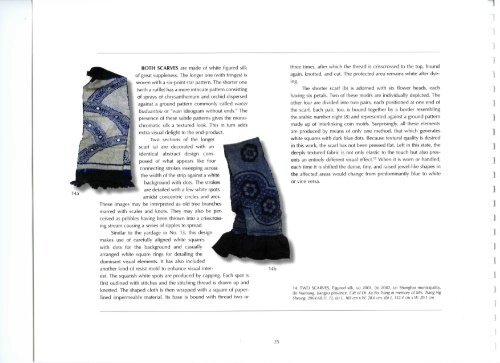Touched by Indigo - Royal Ontario Museum
Touched by Indigo - Royal Ontario Museum
Touched by Indigo - Royal Ontario Museum
You also want an ePaper? Increase the reach of your titles
YUMPU automatically turns print PDFs into web optimized ePapers that Google loves.
14a<br />
BOTH SCARVES are made of white figured silk<br />
of great suppleness. The longer one (with fringes) is<br />
woven with a six-point star pattern. The shorter one<br />
(with a ruffle) has a more intricate pattern consisting<br />
of sprays of chrysanthemum and orchid dispersed<br />
against a ground pattern commonly called wanzi<br />
buduantou or "wan ideogram without ends." The<br />
presence of these subtle patterns gives the monochromatic<br />
silk a textured look. This in turn adds<br />
extra visual delight to the end-product.<br />
Two sections of the longer<br />
scarf (a) are decorated with an<br />
identical abstract design composed<br />
of what appears like four<br />
connecting strokes sweeping across<br />
the width of the strip against a white<br />
background with dots. The strokes<br />
are detailed with a few white spots<br />
amidst concentric circles and arcs.<br />
These images may be interpreted as old tree branches<br />
marred with scales and knots. They may also be perceived<br />
as pebbles having been thrown into a crisscrossing<br />
stream causing a series of ripples to spread.<br />
Similar to the yardage in No. 13, this design<br />
makes use of carefully aligned white squares<br />
with dots for the background and casually<br />
arranged white square rings for detailing the<br />
dominant visual elements. It has also included<br />
another kind of resist motif to enhance visual interest.<br />
The squarish white spots are produced <strong>by</strong> capping. Each spot is<br />
first outlined with stitches and the stitching thread is drawn up and<br />
knotted. The shaped cloth is then wrapped with a square of paperlined<br />
impermeable material. Its base is bound with thread two or<br />
14b<br />
three times, after which the thread is crisscrossed to the top, bound<br />
again, knotted, and cut. The protected area remains white after dyeing.<br />
The shorter scarf (b) is adorned with six flower heads, each<br />
having six petals. Two of these motifs are individually depicted. The<br />
other four are divided into two pairs, each positioned at one end of<br />
the scarf. Each pair, too, is bound together <strong>by</strong> a border resembling<br />
the arabic number eight (8) and represented against a ground pattern<br />
made up of interlinking coin motifs. Surprisingly, all these elements<br />
are produced <strong>by</strong> means of only one method, that which generates<br />
white squares with dark blue dots. Because textural quality is desired<br />
in this work, the scarf has not been pressed flat. Left in this state, the<br />
deeply textured fabric is not only elastic to the touch but also presents<br />
an entirely different visual effect.'1 When it is worn or handled,<br />
each time it is shifted the dense, tiny, and raised jewel-like shapes in<br />
the affected areas would change from predominantly blue to white<br />
or vice versa.<br />
14. TWO SCARVES, Figured silk, (a) 2003, (b) 2002, (a) Shanghai municipality,<br />
(b) Nantong, Jiangsu province. Gift of Dr. Ka Bo Tsang in memory of Mrs. Tsang Ng<br />
Sheung, 2004.68.11, 12, (a) L. 169 cmxW. 28.6 cm, (b) L 132.4 cm x W. 20.1 cm<br />
25
















